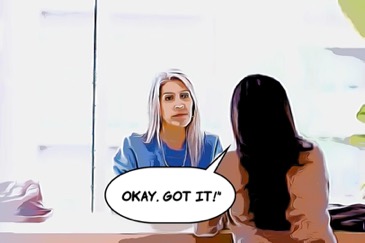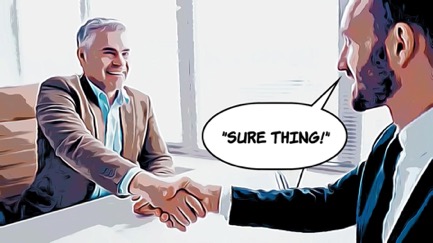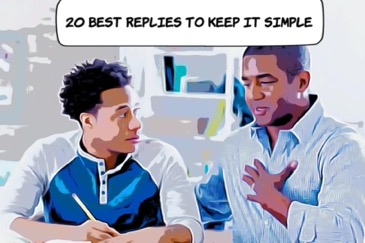In a world inundated with information and complexities, emphasizing simplicity becomes crucial for effective communication and problem-solving. It helps to reduce confusion, prevent misunderstandings, and promote better engagement and collaboration.
By embracing simplicity, we can ensure that our messages are easily comprehensible, our actions are clear and purposeful, and our interactions are more meaningful and productive.
It is about finding the balance between brevity and clarity, avoiding unnecessary jargon or convoluted explanations, and prioritizing the essential aspects of the subject at hand.
Before delving into the exploration of the best responses to ‘keep it simple,’ let’s first understand the meaning and essence of this subject.
Keeping it simple refers to the intentional act of streamlining and simplifying communication, tasks, processes, or interactions to enhance clarity, understanding, and efficiency.
It involves distilling complex ideas or information into concise and easily understandable forms, eliminating unnecessary complexities, and focusing on the core message or objective.
20 Best Replies to “Keep It Simple”
- Okay, got it!’
- ‘I understand’
- ‘Sure thing!’
- ‘No problem’
- ‘Absolutely!’
- ‘I’ll do my best’
- ‘That works’
- ‘I agree’
- ‘I’m on it’
- ‘Thanks for letting me know’
- ‘I’ll take care of it’
- ‘Sounds good to me’
- ‘I appreciate your input’
- ‘I’ll keep that in mind’
- ‘I’ll make sure it gets done’
- ‘I’ll get back to you soon’
- ‘I’ll handle the rest’
- ‘Thanks for the heads up’
- ‘I’ll double-check that’
- ‘Consider it done!’
Okay, Got It!’

When someone tells you to ‘keep it simple,’ they’re basically asking you to make things less complicated or overwhelming. It’s like they’re saying, ‘Hey, could you please make this easier for me to understand or follow?’
In response, saying ‘Okay, got it!’ is a great way to show that you’ve understood their request and you’re on the same page. It’s like giving them a nod and letting them know that you’re ready to simplify things for their benefit
It shows that you’re not just acknowledging their request, but also actively embracing the idea of simplicity and ready to adapt your approach accordingly.
‘I understand’
Using ‘I understand’ as a response when someone says ‘keep it simple’ is a straightforward and concise way to acknowledge their request.
While ‘I understand’ may not have the same level of enthusiasm or engagement as other responses, it can be appropriate in certain situations. It is particularly suitable in more formal or professional settings where a concise and professional tone is desired.
‘Sure Thing!’

When someone emphasizes the importance of keeping things simple, responding with ‘Sure thing!’ conveys a sense of agreement, responsiveness, and enthusiasm in a more formal context.
In a professional setting, clarity and conciseness are often valued. Adding expressions like ‘Sure thing!’ in a more formal context can help strike a balance between being engaging and maintaining a professional tone.
It indicates your responsiveness and readiness to address their concerns while still adhering to the appropriate level of formality.
‘No problem’
Using ‘No problem’ as a response when someone says ‘keep it simple’ communicates a relaxed and accommodating attitude while still acknowledging their request.
It suggests that you are open to simplifying things and that it won’t be an issue for you. Also, it plays off the idea that their request aligns with your approach, and you are confident in your ability to simplify things.
It’s a concise and friendly way to acknowledge their preference while assuring them that it won’t pose any difficulty.
‘Absolutely!’

Responding to ‘keep it simple,’ responding with ‘Absolutely!’ conveys a strong agreement and enthusiastic endorsement of the person’s request.
‘Absolutely!’ as a response signifies that you wholeheartedly understand and support their desire for simplicity. It demonstrates your unwavering commitment to aligning with their preference and ensuring that things are straightforward and easy to understand.
This response adds a sense of enthusiasm, engagement, and dedication to the conversation. It shows that you are not only receptive to their request but also actively embrace the idea of simplicity as a guiding principle.
‘I’ll Do My Best’
Here, ‘I’ll do my best’ conveys a willingness to meet their request to the best of your abilities. This response reflects a sense of responsibility and a proactive approach to meeting their expectations.
It acknowledges that simplicity is valued and that you are willing to put in the effort to simplify the situation or communication.
It shows that you acknowledge their emphasis on simplicity and assure them that you will make every effort to adhere to their preference.
It demonstrates your commitment and dedication to ensuring that things remain straightforward and easy to understand.
‘That works’

By saying ‘That works,’ you acknowledge their emphasis on simplicity and convey that their suggestion or request aligns with your understanding and plans.
It shows that you are on board with their idea and agree that it will be effective in achieving the desired simplicity.
This response is concise yet effective in conveying your agreement and acceptance. It signals that you recognize the value of keeping things simple and are open to adopting the suggested approach or solution.
‘That works’ is generally seen as a casual and agreeable response, suitable for more informal or collaborative settings. In formal or professional contexts, you might consider using a response that maintains a higher level of formality and clarity.
‘I Agree’
‘I agree’ is generally seen as a concise and straightforward response, suitable for various formal and informal situations.
With this response, you indicate that you share the same perspective and recognize the value of keeping things straightforward.
It shows that you acknowledge their emphasis on simplicity and are in accord with their request. It may be particularly appropriate when the conversation emphasizes consensus and a shared understanding.
‘I’m On It’
This response conveys a sense of responsibility and initiative. It shows that you are taking ownership of the situation and are committed to ensuring that things remain straightforward and uncomplicated.
‘I’m on it’ is a concise and assertive response that communicates your dedication to addressing the need for simplicity. It reassures the other person that they can rely on you to handle the matter with attention and focus.
By saying ‘I’m on it,’ you express your proactive approach to the situation or task at hand. It signifies that you understand their emphasis on simplicity and that you are prepared to actively work towards achieving it.
‘Thanks For Letting Me Know’
‘Thanks for letting me know’ is a polite and appreciative response that acknowledges the value of the information shared with you. It establishes a positive tone and promotes further collaboration and understanding.
This response conveys a sense of respect and openness to receiving feedback. It indicates that you are willing to consider their point of view and take it into account as you proceed.
While ‘Thanks for letting me know’ is generally seen as a polite and gracious response, it may not be appropriate in situations that require a more assertive or proactive approach.
‘I’ll Take Care Of It’
‘I’ll take care of it’ is a concise and assertive response that conveys your dedication to addressing the need for simplicity. It demonstrates your willingness to take action and work towards a straightforward resolution.
This response shows that you are willing to assume ownership of the task or situation at hand. It reassures the other person that they can rely on you to handle the matter and simplify it effectively.
By saying ‘I’ll take care of it,’ you convey a sense of responsibility and proactivity. It signifies that you understand the need for simplicity and that you are prepared to take the necessary actions to achieve it.
‘Sounds Good To Me’
‘Sounds good to me’ is a concise and casual response that conveys your agreement and acceptance.This response reflects a positive and collaborative tone.
It suggests that you are on board with their suggestion and believe it to be a suitable and effective way to achieve simplicity.
By saying ‘Sounds good to me,’ you convey that you find their suggestion or request agreeable and in line with your own thoughts. It shows that you are receptive to the idea of simplicity and supportive of their approach.
‘I appreciate your input’
Of course, you can never go wrong with appreciation. ‘I appreciate your input’ is a polite and gracious response that acknowledges the significance of their contribution.
It fosters a positive and collaborative tone, encouraging further engagement and understanding.
you express your recognition and gratitude for the information or suggestion they provided regarding simplicity. It shows that you value their insight and are receptive to their viewpoint.
‘I’ll keep that in mind’
‘I’ll keep that in mind’ is a concise and respectful response that signals your willingness to be mindful of their input. It demonstrates your openness to incorporating their advice or suggestion into your future actions or decisions.
Responding with ‘I’ll keep that in mind’ when someone emphasizes the importance of ‘keeping it simple’ conveys your intention to remember and consider their suggestion or advice. you acknowledge the value of their input and assure them that you will take their emphasis on simplicity into account.
It shows that you recognize the significance of their suggestion and intend to factor it into your decision-making or actions.
‘I’ll Make Sure It Gets Done’
‘I’ll make sure it gets done’ is a concise and resolute response to ‘keep it simple’ that conveys your confidence and proactive approach.
It reassures the other person that they can rely on you to handle the matter and achieve the intended outcome with simplicity as a guiding principle.
Responding with ‘I’ll make sure it gets done’ when someone emphasizes the importance of ‘keeping it simple’ conveys your dedication and assurance that you will take the necessary steps to accomplish the task or objective while maintaining simplicity.
‘I’ll get back to you soon’
‘I’ll get back to you soon’ is a concise and considerate response that communicates your commitment to follow-up.
It indicates that you are actively working on the matter and will ensure that they receive the necessary information or update without unnecessary delays or complications.
This response reflects your responsiveness and accountability. It assures the other person that you value their input and will take the necessary steps to provide them with the information or update they need in a timely manner.
‘I’ll Handle The Rest’
When someone emphasizes the importance of ‘keeping it simple,’ responding with ‘I’ll handle the rest’ demonstrates your confidence and assurance that you will take care of the remaining tasks or responsibilities while maintaining simplicity.
This response shows that you are willing to take the lead and manage the remaining responsibilities.
It reassures the other person that they can rely on you to handle the tasks effectively and ensure that simplicity is maintained throughout the process.
‘Thanks for the heads up’
Responding with ‘Thanks for the heads up’ when someone emphasizes the importance of ‘keeping it simple’ conveys appreciation for the information or notification they provided and acknowledges the significance of their input.
This response conveys a sense of gratitude and acknowledgment. It indicates that you recognize the value of their input and that you are receptive to their emphasis on simplicity.
It further shows that you value their effort to keep you informed and aware of the importance of keeping things straightforward.
‘I’ll double-check that’
‘I’ll double-check that’ reflects a responsible and meticulous approach. It assures the other person that you take their emphasis on simplicity seriously and will go the extra mile to ensure that everything is accurate and straightforward.
‘Consider it done!’
‘Consider it done!’ is an assertive response to ‘keep it simple’ that conveys your commitment to taking action and achieving the desired result. It reflects your confidence in your ability to complete the task or request while maintaining simplicity as a guiding principle.
By saying ‘Consider it done!’ you express your commitment and determination to complete the task or request in a straightforward and efficient manner. It shows that you understand the importance of simplicity and are ready to take responsibility for ensuring its achievement
Wrap Up
Embracing simplicity allows us to cut through the noise, avoid unnecessary complications, and convey our messages in a concise and impactful manner.
It fosters better comprehension, minimizes misunderstandings, and promotes smoother collaboration with others.
Whether it’s acknowledging the importance of keeping things simple, expressing gratitude for straightforward communication, or confidently taking charge to ensure simplicity in a task, these responses serve as invaluable tools in our communication arsenal.
They enable us to cultivate an environment that values clarity, brevity, and meaningful engagement.
By implementing these responses, we empower ourselves and those around us to embrace simplicity as a guiding principle, leading to enhanced productivity, stronger connections, and more effective problem-solving.
Remember, simplicity doesn’t mean oversimplifying or trivializing; it means finding the most direct and effective way to convey our thoughts and ideas.

